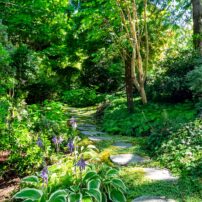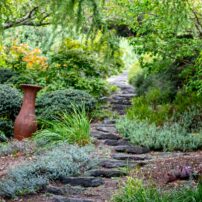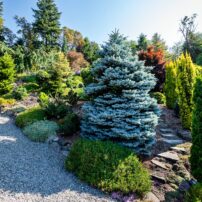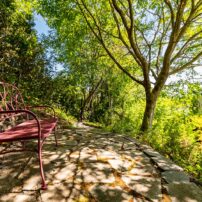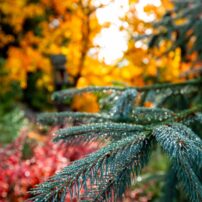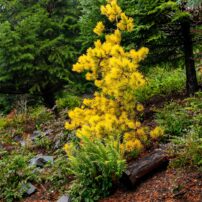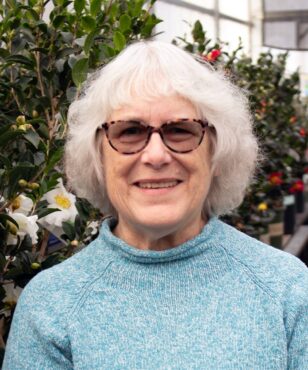 West Sound has three world-class gardens open to the public all year round. The smallest, Vista Gardens, at 4.5 acres, is tucked in against a hillside on 31st Street in East Bremerton.
West Sound has three world-class gardens open to the public all year round. The smallest, Vista Gardens, at 4.5 acres, is tucked in against a hillside on 31st Street in East Bremerton.
 Perhaps 4.5 acres sounds small but this garden is home to myriad amounts of plants, literally thousands. For example, there are over 450 conifers of all sizes and that number is ever expanding because garden creator John Albers loves conifers. Albers and his wife, Santica Marcovina, have spent the last 20-plus years of their lives creating and nourishing their piece of heaven in order to share it entirely with the public. Albers’ passion is plants, plants and more plants while Marcovina has added touches of appealing and inspiring artwork and structures throughout the site.
Perhaps 4.5 acres sounds small but this garden is home to myriad amounts of plants, literally thousands. For example, there are over 450 conifers of all sizes and that number is ever expanding because garden creator John Albers loves conifers. Albers and his wife, Santica Marcovina, have spent the last 20-plus years of their lives creating and nourishing their piece of heaven in order to share it entirely with the public. Albers’ passion is plants, plants and more plants while Marcovina has added touches of appealing and inspiring artwork and structures throughout the site.
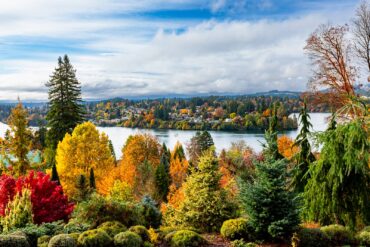 Vista Gardens has had several names. Albers, Marcovina and community members including the past and present mayors of Bremerton formed a nonprofit and Albers and Marcovina have gifted the 4.5 acres of gardens, paths and buildings to the community, thus creating an “officially” public garden under the new name, Vista Gardens. The garden, website and memberships were launched under the new name in summer of 2024. The foundation board hired Baqi Kopelman as the first director of Vista Gardens this past July.
Vista Gardens has had several names. Albers, Marcovina and community members including the past and present mayors of Bremerton formed a nonprofit and Albers and Marcovina have gifted the 4.5 acres of gardens, paths and buildings to the community, thus creating an “officially” public garden under the new name, Vista Gardens. The garden, website and memberships were launched under the new name in summer of 2024. The foundation board hired Baqi Kopelman as the first director of Vista Gardens this past July.

A Bit of History
In 1995, Albers and Marcovina started turning over 2 acres of lawn into sustainable and ever-changing gardens. The total acreage that evolved into the gardens was 4, but a half acre was purchased several years ago to save a California redwood. It’s estimated the magnificent redwood might have been planted in the mid 1800s.
Paths created with natural stone steps meander throughout the hillside areas. Albers brought in (by pickup truck) each stone that was placed by hand to make stairways leading throughout the gardens. There are also level, flatter pathways and seating areas that capture amazing views of Dyes Inlet. The site has 15 separate gardens, each one flowing seamlessly, peacefully and enticingly from one section into the other.
Through the years, a composting area has evolved and a gazebo and greenhouse have been built. A two-story building was also added, housing the Vista Gardens office, library and an upstairs apartment where speakers can reside when they visit.
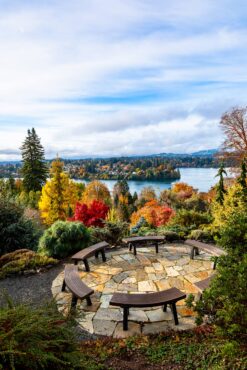 Conifers Galore
Conifers Galore
Albers has a passion for conifers. More than 450 individual conifers, from smallest to largest, festoon and meander throughout the site. From the beginning, a young teen, Sam Pratt, volunteered at the garden, particularly falling in love with conifers just as Albers has. Pratt now lives in Oregon, is married, started his family and is the sales and inventory manager and resident expert for Conifer Kingdom in Silverton. Conifer Kingdom has harvested seeds for propagation from many of the 450-plus conifers at Vista Gardens. Pratt is one of the experts featured as speakers at Vista Gardens during the year. One of the 15 gardens, Sam’s Conifer Reserve, features rare and dwarf conifers in every shape, form, color and texture.
John Lenz Garden and Betty Albers Garden
Rhododendrons galore honor John Lenz, who was a foremost expert on rhododendrons. The garden features rhododendrons, several types of ground covers, maples and Japanese cedars. The pathway from this area leads into the Betty Albers Garden, described as a “sunny, meditative space with a drought-tolerant lawn, flowering trees and shrubs.” Albers’ mother lived into her 90s and actually got to see and experience the plantings at Vista Gardens.
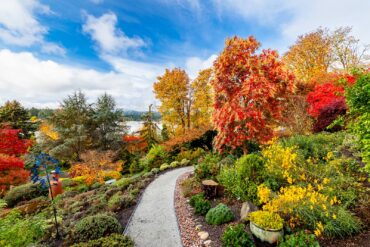 Trees, Trees and More Trees
Trees, Trees and More Trees
Nearly every area features either deciduous or evergreen trees, strategically placed and wonderfully chosen to catch the viewer’s eyes. Every tree was chosen to live in the soil on the site with no amendments other than a bit of compost when needed.
Parts of the 4.5 acres were once a plum orchard. The trees throughout the garden areas provide color, texture and interest through the seasons each year. Myriad colors paint a tapestry in autumn. Blooms and blossoms attract pollinators in spring and summer.
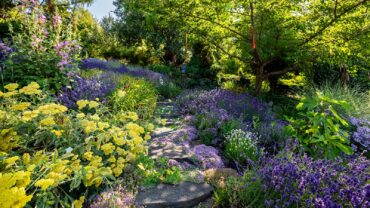 Clusters of madronas can be seen in several areas. One section of madronas features a path through the trees on either side. Also interspersed in this area are big leaf maple, beaked hazelnut and native ground covers. Some of the madronas on the site have been impacted and even killed by a fungal disease. The Vista Gardens Foundation has mounted a fundraiser to remove dead trees and replace with newer, disease-resistant madronas.
Clusters of madronas can be seen in several areas. One section of madronas features a path through the trees on either side. Also interspersed in this area are big leaf maple, beaked hazelnut and native ground covers. Some of the madronas on the site have been impacted and even killed by a fungal disease. The Vista Gardens Foundation has mounted a fundraiser to remove dead trees and replace with newer, disease-resistant madronas.
Places for Rest and Rejuvenation
Benches and seating areas are placed throughout the site. Each area has eye-catching views of water and skyline, along with glimpses of wildlife now and then. Artwork chosen by Marcovina adds interest and inspiration in each garden area.
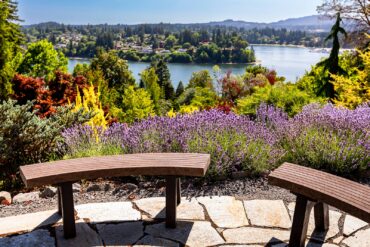 Abundant Learning Opportunities
Abundant Learning Opportunities
Vista Gardens features various demonstration garden areas where visitors can learn what plants grow best in our changing climate and in various light and soil conditions. A rain garden and biofiltration area show how ornamental grasses and drought-tolerant herbs work well to filter water and capture runoff from rain events.
Vista Gardens has a focus on diverse plantings, adapting to changing climates, sustainability and healthy ecosystems. Each month features a great selection of classes. The library offers books for research during a visit to the site.
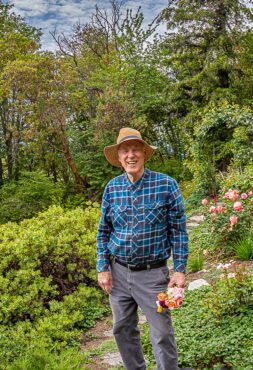
Albers the Author
In addition to sharing Vista Gardens with the public, Albers also has a passion for writing about plants, sustainability, gardening and the gardens surrounding his property. He has written three books and has a fourth one in process. The books are available when visiting Vista Gardens and at local bookstores. Here are his books so far:
- “Gardening for Sustainability” — featuring photos and information about the formation of Vista Gardens and the plants found there
- “Growing Conifers” — everything you need to successfully grow conifers, great photos and lists of information
- “The Northwest Garden Manifesto (Create, Restore and Maintain a Sustainable Yard)“
Renowned photographer David E. Perry is the photographer for all three books. In addition, some of the photos in the first book were provided by Stefano Politi Markovina.
The latest book in process includes information about the myriad plants at Vista Gardens and will have photos from Perry and Baqi Kopelman. Eventually all the Vista Garden plants with photos will be in a data bank for reference and research. Kopelman, Albers and volunteers are undertaking this process.
 Garden Opens and Classes
Garden Opens and Classes
Vista Gardens is open to the public from 10 a.m. to noon Thursdays and Saturdays during September, October and November. Additionally, Sundays in the fall (when fall color is exuberantly on display) has available hours. Tours and individual visits can be scheduled by emailing or calling Vista Gardens.
From May through August, open garden days are from 10 a.m. to noon Thursday, Friday and Sunday, with tours on Saturdays. Visitors are able to stay in the gardens as long as they like (even after the noon arrival time cutoff).
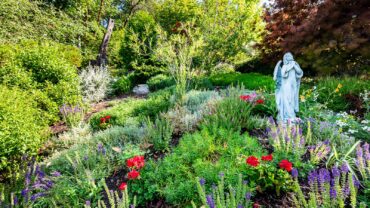 Albers is often found walking throughout the gardens and he enjoys answering questions and giving tours.
Albers is often found walking throughout the gardens and he enjoys answering questions and giving tours.
Memberships to the garden are $30 for individuals and $40 for a family. Membership includes half off on classes and workshops. Three local nurseries offer 10% off purchases for Vista Gardens members — just display your membership card.
Truly two hours and one visit are not nearly enough to take in all the abundance, variety and beauty of Vista Gardens. You’ll want to become a member so you can return again and again.




